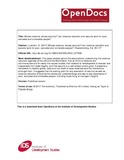Whose Violence, Whose Security? Can Violence Reduction and Security Work for Poor, Excluded and Vulnerable People?
| dc.contributor.author | Luckham, Robin | |
| dc.date.accessioned | 2018-05-03T14:07:26Z | |
| dc.date.available | 2018-05-03T14:07:26Z | |
| dc.date.issued | 2017-02 | |
| dc.identifier.citation | Luckham, R. (2017) Whose Violence, Whose Security? Can Violence Reduction and Security Work for Poor, Excluded and Vulnerable People?, Peacebuilding, 5:2, 99-117 | en |
| dc.identifier.uri | https://opendocs.ids.ac.uk/opendocs/handle/20.500.12413/13714 | |
| dc.description.abstract | This paper probes behind the assumptions underpinning the violence reduction agendas of the UN and the World Bank: that all forms of violence are commensurate and fit neatly into causal models; that violence is ‘development in reverse’ and inseparable from state fragility; and that security is a self-evident public good. It presents a framework to classify global, state and non-state or local violences and the interactions amongst them. It suggests that the starting point for any evaluation of security as well as violence reduction should be the vernacular understandings and day-to-day experience of poor, excluded and vulnerable people, including those living at insurgent margins. | en |
| dc.language.iso | en | en |
| dc.publisher | Routledge | en |
| dc.rights | © 2017 The author(s). Published by informa uK limited, trading as Taylor & Francis group. This is an Open access article distributed under the terms of the creative commons attribution-noncommercial-noderivatives license (http://creativecommons.org/licenses/by-nc-nd/4.0/), which permits non-commercial re-use, distribution, and reproduction in any medium, provided the original work is properly cited, and is not altered, transformed, or built upon in any way. | en |
| dc.rights.uri | http://creativecommons.org/licenses/by-nc-nd/4.0/ | en |
| dc.subject | Security and Conflict | en |
| dc.title | Whose Violence, Whose Security? Can Violence Reduction and Security Work for Poor, Excluded and Vulnerable People? | en |
| dc.type | Article | en |
| dc.identifier.externaluri | http://dx.doi.org/10.1080/21647259.2016.1277009 | en |
| dc.identifier.team | Governance | en |
| dc.identifier.doi | 10.1080/21647259.2016.1277009 | |
| rioxxterms.funder | Default funder | en |
| rioxxterms.identifier.project | Default project | en |
| rioxxterms.version | VoR | en |
| rioxxterms.versionofrecord | http://dx.doi.org/10.1080/21647259.2016.1277009 | en |
| rioxxterms.funder.project | 9ce4e4dc-26e9-4d78-96e9-15e4dcac0642 | en |
Files in this item
This item appears in the following Collection(s)
Except where otherwise noted, this item's license is described as © 2017 The author(s). Published by informa uK limited, trading as Taylor & Francis group. This is an Open access article distributed under the terms of the creative commons attribution-noncommercial-noderivatives license
(http://creativecommons.org/licenses/by-nc-nd/4.0/), which permits non-commercial re-use, distribution, and reproduction in any medium, provided the original work is properly cited, and is not altered, transformed, or built upon in any way.


